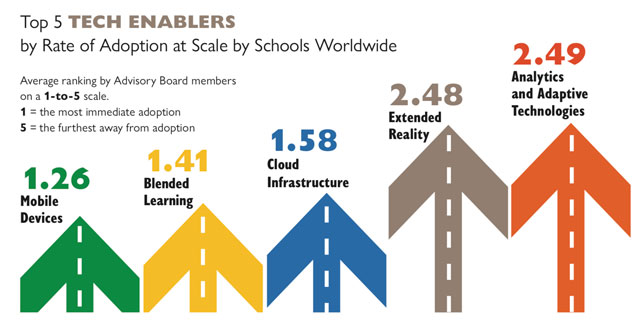5 Tools for Technology Transformation in Schools
A new report from CoSN explores five ways that technology has the ability to accelerate K-12 innovation.
With the accelerating pace of new technologies for the classroom, the Consortium for School Networking wants to help schools overcome hurdles in adopting new innovations. A new report from CoSN identifies the top five technology enablers that will help K-12 institutions find more expansive opportunities and solutions in education. These enablers are:
- Mobile devices (defined as "hand-held or wearable tools that are internet-connected and enable knowledge consumption/creation);
- Blended learning ("the provision of learning experiences via a mix of face-to-face and online interaction, enabled by a collection of digital tools and technologies");
- Cloud infrastructure ("a virtual infrastructure that is delivered or accessed via a network or the internet, enabling IT services to move away from physically being present in a school");
- Extended reality (encompassing "augmented, virtual and mixed reality — a collection of technologies that enhance the physical world with interactive digital imagery and graphics"); and
- Analytics and adaptive technologies ("technologies that measure learning and enable personalization").

The technologies were selected by CoSN's advisory board, with over 100 members from U.S. and international education organizations and ministries of education. This report is the third part of a new CoSN annual series that tackles the hurdles, accelerators and technology enablers behind K-12 technology innovation.
"As innovation races ahead, tech enablers help school technology leaders make a smooth transition to modern, personalized learning environments," said CoSN CEO Keith Krueger. "Taken together, CoSN's complete series gives educators forward-thinking insights to make the most of their own district's opportunities."
In particular, the report goes into more depth on blended learning as well as analytics and adaptive technologies. In order to drive innovation with blended learning, the report makes some suggestions:
- Identify a problem or an opportunity to address;
- Define a vision, goals and measurements;
- Engage the community;
- Discuss teaching and learning models and methods to ensure they fit the context of the school system or school;
- Select digital technologies that support your goals — and make sure that the technology infrastructure can support these technologies;
- Provide professional development for leaders and teachers;
- Foster a supportive school climate and culture; and
- Create flexible teaching and learning environments.
When it comes to analytics and adaptive technologies, the report encourages educators to utilize these kinds of tools, but recognizes that there could be tensions over how these analytical tools collect data. Concerns around data privacy and data quality are issues that need to be addressed.
In addition, there could be some debate around the role of the educator in using these analytical and adaptive tools. Rather than relying on these tools to provide guidance and support, the report said, the focus should be about using this technology to provide personalized instruction and to save time for personal interactions between educators and students.
For more information, the full copy of the report is available with registration through the CoSN website.
About the Author
 Sara Friedman is a reporter/producer for Campus Technology, THE Journal and STEAM Universe covering education policy and a wide range of other public-sector IT topics.
Sara Friedman is a reporter/producer for Campus Technology, THE Journal and STEAM Universe covering education policy and a wide range of other public-sector IT topics.
Friedman is a graduate of Ithaca College, where she studied journalism, politics and international communications.
Friedman can be contacted at [email protected] or follow her on Twitter @SaraEFriedman.
Click here for previous articles by Friedman.